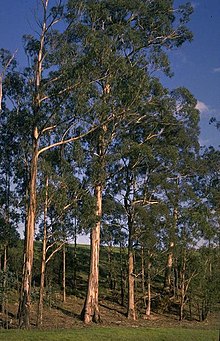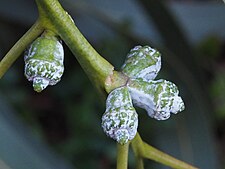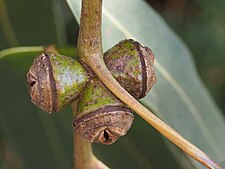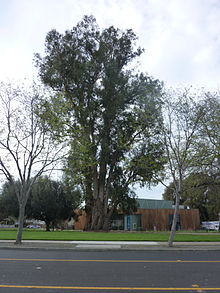Eucalyptus globulus
| Blue gum | |
|---|---|

| |
| Eucalyptus globulus subsp. maidenii | |
| Scientific classification | |
| Kingdom: | Plantae |
| Clade: | Tracheophytes |
| Clade: | Angiosperms |
| Clade: | Eudicots |
| Clade: | Rosids |
| Order: | Myrtales |
| Family: | Myrtaceae |
| Genus: | Eucalyptus |
| Species: | E. globulus
|
| Binomial name | |
| Eucalyptus globulus | |
| Synonyms[1] | |
| |


Eucalyptus globulus, commonly known as southern blue gum[2] or blue gum, is a species of flowering plant in the family Myrtaceae. It is a tall, evergreen tree endemic to southeastern Australia. This Eucalyptus species has mostly smooth bark, juvenile leaves that are whitish and waxy on the lower surface, glossy green, lance-shaped adult leaves, glaucous, ribbed flower buds arranged singly or in groups of three or seven in leaf axils, white flowers and woody fruit.
There are four subspecies, each with a different distribution across Australia, occurring in New South Wales, Victoria and Tasmania. The subspecies are the Victorian blue gum, Tasmanian blue gum, Maiden's gum, and Victorian eurabbie.
Description
[edit]Eucalyptus globulus is a tree that typically grows to a height of 45 m (148 ft) but may sometimes only be a stunted shrub, or alternatively under ideal conditions can grow as tall as 90–100 m (300–330 ft), and forms a lignotuber. The bark is usually smooth, white to cream-coloured but there are sometimes slabs of persistent, unshed bark at the base. Young plants, often several metres tall, and coppice regrowth have stems that are more or less square in cross-section with a prominent wing on each corner. Juvenile leaves are mostly arranged in opposite pairs, sessile, glaucous elliptic to egg-shaped, up to 150 mm (5.9 in) long and 105 mm (4.1 in) wide. Adult leaves are arranged alternately, the same glossy to dark green on both sides, lance-shaped or curved, 150–300 mm (5.9–11.8 in) long and 17–30 mm (0.67–1.18 in) wide on a petiole 1.5–6 mm (0.059–0.236 in) long. The flower buds are arranged singly or in groups of three or seven in leaf axils, sometimes sessile or on a short thick peduncle. The individual buds are also usually sessile, sometimes on a pedicel up to 5 mm (0.20 in) long. Mature buds are top-shaped to conical, glaucous or green, with a flattened hemispherical, warty operculum with a central knob. Flowering time varies with subspecies and distribution but the flowers are always white. The fruit is a woody conical or hemispherical capsule with the valves close to rim level.[2][3][4][5][6][7][8]
Taxonomy and naming
[edit]Eucalyptus globulus was first formally described in 1800 by the French botanist Jacques Labillardière in his book, Relation du Voyage à la Recherche de la Pérouse.[9][10][11] Labillardière collected specimens at Recherche Bay during the d'Entrecasteaux expedition in 1792.[12]
The d'Entrecasteaux expedition made immediate use of the species when they discovered it, the timber being used to improve their oared boats.[12] The Tasmanian blue gum was proclaimed as the floral emblem of Tasmania on 27 November 1962. The species name is from the Latin globulus, a little ball or small sphere,[13] referring to the shape of the fruit.[3]
In 1974, James Barrie Kirkpatrick described four subspecies and the names have been accepted by the Australian Plant Census.[14] Each subspecies has a characteristic arrangement of its flower buds:[15]
- Eucalyptus globulus subsp. bicostata (Maiden, Blakely & Simmonds) J.B.Kirkp. (formerly Eucalyptus bicostata), commonly known as Victorian blue gum or eurabbie, has sessile flower buds arranged in groups of three;[16][4]
- Eucalyptus globulus Labill. subsp. globulus, commonly known as Tasmanian blue gum, has flower buds arranged singly in leaf axils;[3][17]
- Eucalyptus globulus subsp. maidenii (F.Muell.) J.B.Kirkp. (formerly Eucalyptus maidenii), commonly known as Maiden's gum has flower buds arranged in groups of seven[18][5]
- Eucalyptus globulus subsp. pseudoglobulus (Naudin) J.B.Kirkp. (formerly Eucalyptus globulus var. pseudoglobulus), commonly known as Victorian eurabbie has pedicellate flower buds arranged in groups of three.[19][6]
Distribution and habitat
[edit]Blue gum grows in forests in New South Wales, Victoria and Tasmania, including some of the Bass Strait Islands. Subspecies bicostata occurs in montane and tableland areas between the Carrai Plateau in northern New South Wales and the Pyrenees in Victoria. Subspecies globulus is mainly found in lowland parts of Tasmania, but is also found on some Bass Strait islands including King Island, and in the extreme south-west of Victoria. Subspecies maidenii occurs on near-coastal ranges of south-eastern New South Wales and eastern Victoria. Subspecies pseudoglobulus is mostly distributed in eastern Gippsland but there are isolated populations further inland and in the Nadgee Nature Reserve in south-eastern New South Wales.[3]
There are naturalised non-native occurrences in Spain and Portugal, and other parts of southern Europe incl. Cyprus, southern Africa, New Zealand, western United States (California), Hawaii, Macaronesia,[20]
-
Eucalyptus globulus growing in Patra, Greece.
Unusual specimens
[edit]They typically grow from 30–55 m (98–180 ft) tall. There are historical claims of even taller trees with Robert Edwards Carter Stearns claiming that when he was alive, they were capable of growing to 400 feet.[21] While this claim is often regarded as being exaggerated, the environmentalist Jared Diamond argues in favor of this claim, stating that such trees were likely cut down during the colonization of Australia by the English.[22] Tasmanian D. W. Lewin claimed that the tallest was 101 m (331 ft).[23]
Plantations
[edit]
Blue gum is one of the most extensively planted eucalypts. Its rapid growth and adaptability to a range of conditions is responsible for its popularity. It is especially well-suited to countries with a Mediterranean-type climate, but also grows well in high altitudes in the tropics.[24]
It comprises 65% of all plantation hardwood in Australia with approximately 4,500 km2 (1,100,000 acres) planted.[25]
In about 1860 Francis Cook planted the tree on Monserrate Palace, his property at Sintra in Portugal and within twenty years it had attained the height of 100 m and a circumference of 5 m.[citation needed] [dubious – discuss]By 1878 the tree ″had spread from one end of Portugal to the other″. In 1878 the tree was also planted, partly on Cook's recommendation, in Galway, Ireland to reclaim ″useless bog land″.[26]
E. globulus begun to be planted as plantations in Los Lagos and Los Ríos regions of Chile in the 1990s.[27] However at these latitudes around the 40th parallel south the tree is at the southern border of the climatic conditions where it can grow, hence good growth in this part of southern Chile requires good site selection such as sunny north-facing slopes.[27] Some of these plantations grow on red clay soil.[27]
Uses
[edit]Timber
[edit]Blue gum timber is yellow-brown, fairly heavy, with an interlocked grain, and is difficult to season.[28] It has poor lumber qualities due to growth stress problems, but can be used in construction, fence posts and poles.[29]
Pulpwood
[edit]Essential oil
[edit]The leaves are steam distilled to extract eucalyptus oil. E. globulus is the primary source of global eucalyptus oil production, with China being the largest commercial producer.[30][31] The oil has therapeutic, perfumery, flavoring, antimicrobial and biopesticide properties.[32][33][34] Oil yield ranges from 1.0 to 2.4% (fresh weight), with cineole being the major isolate. E. globulus oil has established itself internationally because it is virtually phellandrene free, a necessary characteristic for internal pharmaceutical use.[35] In 1870, Cloez identified and ascribed the name "eucalyptol" — now more often called cineole — to the dominant portion of E. globulus oil.[36]
Herb tea
[edit]Tasmanian blue gum leaves are used as a herbal tea.[37]
Phenolics
[edit]E. globulus bark contains quinic, dihydroxyphenylacetic and caffeic acids, bis(hexahydroxydiphenoyl (HHDP))-glucose, galloyl-bis(HHDP)-glucose, galloyl-HHDP-glucose, isorhamentin-hexoside, quercetin-hexoside, methylellagic acid (EA)-pentose conjugate, myricetin-rhamnoside, isorhamnetin-rhamnoside, mearnsetin, phloridzin, mearnsetin-hexoside, luteolin and a proanthocyanidin B-type dimer, digalloylglucose and catechin.[38] The hydrolyzable tannins tellimagrandin I, eucalbanin C, 2-O-digalloyl-1,3,4-tri-O-galloyl-β-D-glucose, 6-O-digalloyl-1,2,3-tri-O-galloyl-β-D-glucose, as well as gallic acid and (+)-catechin can also be isolated.[39] Tricetin is a rare flavone aglycone found in the pollen of members of the Myrtaceae, subfamily Leptospermoideae, such as E. globulus.[40]
See also
[edit]References
[edit]- ^ a b "Eucalyptus globulus". Australian Plant Census. Retrieved 17 July 2019.
- ^ a b Brooker, M. Ian H. "Eucalyptus globulus". Royal Botanic Gardens Victoria. Retrieved 18 July 2019.
- ^ a b c d "Eucalyptus globulus subsp. globulus". Euclid: Centre for Australian National Biodiversity Research. Retrieved 2 June 2020.
- ^ a b "Eucalyptus globulus subsp. bicostata". Euclid: Centre for Australian National Biodiversity Research. Retrieved 31 March 2021.
- ^ a b "Eucalyptus globulus subsp. maidenii". Euclid: Centre for Australian National Biodiversdity Research. Retrieved 31 March 2021.
- ^ a b "Eucalyptus globulus subsp. pseudoglobulus". Euclid: Centre for Australian National Biodiversity Research. Retrieved 31 March 2021.
- ^ Chippendale, George M. "Eucalyptus globulus". Australian Biological Resources Study, Department of the Environment and Energy, Canberra. Retrieved 18 July 2019.
- ^ "Eucalyptus globulus". Kew: Plants of the World online. Retrieved 18 July 2019.
- ^ "Eucalyptus globulus". APNI. Retrieved 17 July 2019.
- ^ La Billardière, Jacques-Julien Houtou de (1800). Relation du Voyage à la Recherche de la Pérouse. Paris: chez H. J. Jansen. p. 13. Retrieved 17 July 2019.
- ^ La Billardière, Jacques-Julien Houtou de (1800). Relation du Voyage à la Recherche de la Pérouse. Paris: chez H. J. Jansen. p. 153. Retrieved 17 July 2019.
- ^ a b Mulvaney, John (c. 2006). "4. Botanising". 'The axe had never sounded': place, people and heritage of Recherche Bay, Tasmania (Online ed.). Australian National University. ISBN 978-1-921313-21-9. Retrieved 16 February 2009.
- ^ Brown, Roland Wilbur (1956). The Composition of Scientific Words. Washington, D.C.: Smithsonian Institution Press. p. 119.
- ^ Kirkpatrick, James Barrie (September 1974). "The numerical intraspecific taxonomy of Eucalyptus globulus Labill. (Myrtaceae)". The Botanical Journal of the Linnean Society. 69 (2): 89–104. doi:10.1111/j.1095-8339.1974.tb01618.x.
- ^ Brooker, M. Ian H.; Slee, Andrew V. "Key to the subspecies of Eucalyptus globulus". Royal Botanic Gardens, Victoria. Retrieved 18 July 2019.
- ^ "Eucalyptus globulus subsp. bicostata". Australian Plant Census. Retrieved 17 July 2019.
- ^ "Eucalyptus globulus subsp. bicostata". Australian Plant Census. Retrieved 31 March 2021.
- ^ "Eucalyptus globulus subsp. maidenii". Australian Plant Census. Retrieved 17 July 2019.
- ^ "Eucalyptus globulus subsp. maidenii". Australian Plant Census. Retrieved 17 July 2019.
- ^ "Eucalyptus globulus". Germplasm Resources Information Network. Agricultural Research Service, United States Department of Agriculture. Retrieved 12 December 2017.
- ^ "Blunder from Down Under".
- ^ Jared Diamond, Collapse: How Societies Choose to Fail or Succeed pg 382.
- ^ Lewin, D. W. (1906). "The Eucalypti Hardwood Timbers of Tasmania". Tasmania, Gray.
- ^ Hillis, W.E., Brown, A.G., Eucalypts for Wood Production, Academic Press, 1984, p20, ISBN 0-12-348762-5
- ^ Australia's Plantations 2006 (PDF). Bureau of Rural Sciences. Archived from the original (PDF) on 29 September 2007. Retrieved 24 January 2007.
- ^ "The Eucalyptus for the West of England". The Cornishman. No. 16. 31 October 1878. p. 5.
- ^ a b c Geldres, Edith; Schlatter, Juan E. (2004). "Crecimiento de las plantaciones de Eucalyptus globulussobre suelos rojo arcillosos de la provinciad Osorno, Décima Región" [Growth of Eucalyptus globulus plantations on red clay soils in the Province of Osorno, 10th Region, Chile] (PDF). Bosque (in Spanish). 25 (1): 95–101. doi:10.4067/S0717-92002004000100008. Retrieved 12 January 2019.
- ^ Cribb, A.B. & J.W., Useful Wild Plants in Australia, Collins 1982, p25 ISBN 0-00-636397-0
- ^ "Index of Species Information, Eucalyptus globulus". Archived from the original on 29 August 2012. Retrieved 24 May 2008.
- ^ Edited by Boland, D.J., Brophy, J.J., and A.P.N. House, Eucalyptus Leaf Oils - Use, Chemistry, Distillation and Marketing, Inkata Press, 1991, p4.
- ^ "Eucalyptus Oil, FAO Corporate Document Repository". Archived from the original on 2 May 2012. Retrieved 24 May 2008.
- ^ Eucalyptus globulus Monograph, Australian Naturopathic Network
- ^ "Eucalyptus globulus". Australian Native Plants Society (Australia). Archived from the original on 25 February 2012. Retrieved 29 October 2021.
- ^ Young-Cheol Yang, Han-Young Choi, Won-Sil Choi, J. M. Clark, and Young-Joon Ahn, Ovicidal and Adulticidal Activity of Eucalyptus globulus Leaf Oil Terpenoids against Pediculus humanus capitis (Anoplura: Pediculidae), J. Agric. Food Chem., 52 (9), 2507 -2511, 2004. doi:10.1021/jf0354803
- ^ Edited by Boland, D.J., Brophy, J.J., and A.P.N. House, Eucalyptus Leaf Oils - Use, Chemistry, Distillation and Marketing, Inkata Press, 1991, p3., & pp78-82.
- ^ Boland, D.J., Brophy, J.J., and A.P.N. House, Eucalyptus Leaf Oils, 1991, p6 ISBN 0-909605-69-6
- ^ Eucalyptus Globulus Labill Leaf Pieces Tea
- ^ Santos, SA; Freire, CS; Domingues, MR; Silvestre, AJ; Pascoal Neto, C (2011). "Characterization of phenolic components in polar extracts of Eucalyptus globulus Labill. Bark by high-performance liquid chromatography-mass spectrometry". Journal of Agricultural and Food Chemistry. 59 (17): 9386–93. doi:10.1021/jf201801q. PMID 21761864.
- ^ Hou, Ai-Jun; Liu, Yan-Ze; Yang, Hui; Lin, Zhong-Wen; Sun, Han-Dong (2000). "Hydrolyzable Tannins and Related Polyphenols fromEucalyptus globulus". Journal of Asian Natural Products Research. 2 (3): 205–12. doi:10.1080/10286020008039912. PMID 11256694. S2CID 7759379.
- ^ The Unique Occurrence of the Flavone Aglycone Tricetin in Myrtaceae Pollen. Maria G. Campos, Rosemary F. Webby and Kenneth R. Markham, Z. Naturforsch, 2002, 57c, pages 944-946 (article)
External links
[edit]- Botanical characteristics of Eucalyptus globulus
- Australian National Botanic Gardens
- Chronology of the discovery of Eucalyptus globulus Iglesias Trabado, Gustavo (2007). In: EUCALYPTOLOGICS
-
Shedding bark.
-
Flower bud.
-
Flowers and leaves
-
Fruit.
-
3, 4, 5 & 6 valved fruits.
-
An illustration from Köhler's Medicinal Plants (1887).







